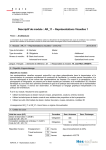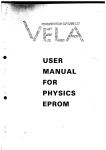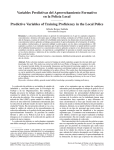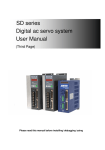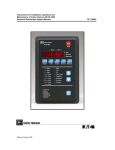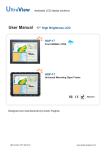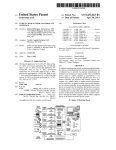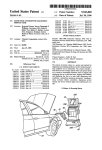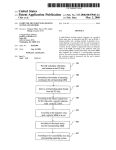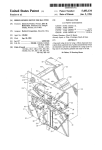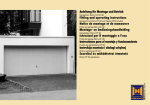Download Diagnosing malfunctions in materials handling vehicles
Transcript
US006212449B1 (12) United States Patent (10) Patent N0.: (45) Date of Patent: Wellman et al. US 6,212,449 B1 Apr. 3, 2001 OTHER PUBLICATIONS (54) DIAGNOSING MALFUNCTIONS IN MATERIALS HANDLING VEHICLES Raymond, EASi Reach Service Manual, Jan. 15, 1995, pp. 47—49 menu description; p. 73 trouble shooting a problem: Code 2A; and, pp. 53—55 total available trouble codes. (75) Inventors: Timothy A. Wellman, ColdWater; James W. Gaskell, Troy; Donald T. Meiring, Osgood, all of OH (US) * cited by examiner (73) Assignee: Crown Equipment Corporation, New Bremen, OH (US) (*) Notice: Primary Examiner—Tan Nguyen Subject to any disclaimer, the term of this patent is extended or adjusted under 35 U.S.C. 154(b) by 0 days. (74) Attorney, Agent, or Firm—King & Schickli PLLC (57) ABSTRACT A diagnosis system for materials handling vehicles leads service personnel step-by-step through diagnosis and repair of faults Within the vehicle. Faults are assigned correspond (21) Appl. No.: 09/161,823 ing event codes so that When a fault is detected, its corre (22) Filed: sponding event code is displayed. The event codes uniquely identify systems of the vehicle in Which faults have occurred by having the event codes for a given vehicle system all start Sep. 28, 1998 Related US. Application Data (60) Provisional application No. 60/060,487, ?led on Sep. 30, 1997. (51) Int. Cl.7 ............................. .. B66F 9/24; G01R 31/00 (52) US. Cl. ............................................... .. 701/29; 701/35 (58) Field of Search ................................ .. 701/29, 30, 32, 701/33, 34, 35; 340/438, 439 (56) References Cited 2/1996 Shirane et al. ....................... .. 701/35 5,528,496 * 6/1996 Brauer et al. 5,539,869 * 7/1996 Spoto et al. .. 5,541,840 * 7/1996 5,579,227 Gurne et al. .. 0 416 171 A2 0 468 805 A2 .. 701/29 395/154 .. 701/29 11/1996 Simmons, Jr. et al. ............. .. 701/29 FOREIGN PATENT DOCUMENTS portion of the vehicle Wherein the malfunction has occurred, the components Which caused the malfunction and, preferably, provides a pictogram of that portion of the vehicle. The technician advances to the malfunctioning portion of the vehicle Where another pictorial depiction of the components of that portion of the vehicle assists in locating the components. All components are marked Within the vehicle by identi?ers Which are consistently used throughout the diagnostic information, pictorial representa U.S. PATENT DOCUMENTS 5,491,631 * With the same number. Thus, the technician knoWs from the event code What system needs to be diagnosed/repaired and What tools and probable parts Will be needed. The event code is used to access diagnosis information identifying the tions and service manuals. The diagnostic information tells the technician What to do to diagnose the components With the diagnosis being preformed using the electronic control system of the vehicle to monitor inputs to and outputs from the electronic control system and to apply limited duration full poWer test signals to components to be tested. The diagnostic information is con?gured so that testing is done from the end of control paths back to the controller. 3/1991 (EP) . 1/1992 (EP) . 22 Claims, 15 Drawing Sheets RRSOOO [15mm SYSTEM 300 340 OUTPUTS U.S. Patent Apr. 3, 2001 Sheet 1 0f 15 US 6,212,449 B1 FIG. 1 \ \ x__\ J90 \ Q 4' . . J $75 /§/ 70 _-> I40 / no 85 ,v- \m i 125 i,» Ma?a‘ Vii/ _ I35 " z’ . ‘O f .- ‘ 40/ I I20 . _ ’ ‘ ' 46 I30 44 I22 ' I I 42 55 60 I5 50 U.S. Patent 200 / Apr. 3, 2001 Sheet 2 0f 15 US 6,212,449 B1 L 225 U.S. Patent Apr. 3, 2001 55 25 0 S25 E2 Sheet 5 0f 15 8h 5: 5 3 £5 w, r o¢m.\ 0m w Pz<o NB’ i\Em US 6,212,449 B1 U.S. Patent Apr. 3, 2001 0mm 3% jjjjjiiiiij 1111111111 J uvdl Sheet 6 0f 15 US 6,212,449 B1 U.S. Patent Apr. 3, 2001 US 6,212,449 B1 Sheet 8 0f 15 FIG.5 DEID E! A ‘ANALYZER “GD C CALIBRATE F FEATURES PREVIOUS MENU OR INCREASE COUNT 220 H HOUR RESET NEXT MENU OR DECREASE COUNT L LOC EVENTS 225 \ : ENTER MENU OR ACCEPT INPUT P PREFORMANCE U UTILITIES U.S. Patent Apr. 3, 2001 Sheet 11 0f 15 US 6,212,449 B1 h I25 .2:;. u mdw o0$5528am o: \ _ Q .0 O OQO O % w omm 5:52 0W9 .m.was‘. . aO 0 . n m. .v. “m: is? N. an. @wQ6Em2cwoaEu2é / ,,5225so £5:E, .w/ .0J09o8 U.S. Patent Apr. 3, 2001 Sheet 12 0f 15 2E25: 25:5we” “13% 5 2 E5%: > .515.%. "1is=2$2.5;1m,i 07:2:2;E . , 3 2 5 ; . 2 E , / .f, Z02 i $ 55 2 3 G5 . 6EQHm:3c25oq0Eou 5.,E;as:$am5 2 2E;25%22a.. 2:E;2 m.0_n 2a:?52 US 6,212,449 B1 U.S. Patent Apr. 3, 2001 $5$8:.55 @WQc5Jo62Wa;QS 9. K Sheet 13 0f 15 E 2 5 2 5 8 % ; 5280m5: 2%: 85$8::5 US 6,212,449 B1 2:.065: 2E.52?: U.S. Patent Apr. 3, 2001 Sheet 15 0f 15 US 6,212,449 B1 F I G. 12 smus cone POT2 (RAISE/LOWER) ABOVE ELECTRICAL LIMIT STEP 1i TURN KEY ON WHILE PRESSINC THE @ BUTTON. SELECT POT2 IAZAI ON DISPLAY MENU. MOVE CONTROL HANDLE TO CONFIRM THE FOLLOWING READINGS. IFI APPROXIMATELY 5 VOLTS. OPEN IN CIRCUIT BETWEEN POTENTIOMETER AND CA405-16 OR CA405-8 ON ACCESS 2. OKAY, REPLACE POTENTIOMETER. IFI APPROXIMATELY 2.5 VOLTS RAISE/LOWER HANDLE IS IN CENTER POSITION. CORRECT READING IFI APPROXIMATELY L2 VOLTS RAISE/LOWER HANDLE IS IN FULL UP POSITION. CORRECT READIN IF: APPROXIMATELY 3.8 VOLTS RAISE/LOWER HANDLE IS IN FULL LOWER POSITION. CORRECT READING CORRECT READINGS CONFIRMED, INTERMITTENT CONNECTION LIIIELY IN POTENTIOMETER CIRCUIT THEN CHECK CONNECTIONS AND POTENTIOMETER NOTE: ADJUST AND CALIBRATE THE POTENTIOMETER AFTER REPAIR. MULTI -TASK CONTROL ACCESS 2 :0 CA405 ~16 US 6,212,449 B1 1 2 DIAGNOSING MALFUNCTIONS IN MATERIALS HANDLING VEHICLES properly functioning components. Preferably, such an CROSS-REFERENCE TO RELATED APPLICATIONS corrected With the procedure not only leading the repair person to faulty components but clearly indicating the improved diagnostic arrangement Would folloW a set pro cedure regardless of the location of faults Which need to be identity and location of those components on the vehicle This application claims the bene?t of US. Provisional through directions, maps and component identi?cation labeling. In addition, the directions, maps and component Application Number 60/060,487, ?led Sep. 30, 1997, Which is incorporated herein by reference. BACKGROUND OF THE INVENTION 10 provided to the service person on-time, rather than being The present invention relates in general to materials handling vehicles and, more particularly, to diagnosing and repairing such vehicles. While the present invention is generally applicable to materials handling vehicles, it Will be described herein With reference to a rider reach fork lift truck presented as a mass of information Which can overWhelm, frustrate and delay diagnosis and repair. 15 SUMMARY OF THE INVENTION This need is met by the invention of the present applica tion Wherein a diagnosis system leads service personnel for Which it is particularly applicable and for Which it is initially being utiliZed. Materials handling vehicle repairs and service have con ventionally been handled by trained personnel Who are familiar With vehicles in need of diagnosis and repair. identi?cation labels should be provided to the service person as needed in the diagnostic process, i.e., information is step-by-step through diagnosis and repair of faults Which might occur in a materials handling vehicle. Possible faults 20 Within a vehicle are assigned to status or event codes Which Control systems in these vehicles may generate an event correspond one-to-one With the faults. Accordingly, When a code prior to being shut doWn to prevent possible damage to fault is detected, its corresponding event code is generated the vehicle due to a fault. Trained repair personnel Were then faced With a dead vehicle With no information regarding the fault or, at best, Were provided With an event code Which identi?ed the general area of the vehicle Wherein a fault had and displayed to the operator of the vehicle as Well as being stored in a history of logged events. 25 The event codes uniquely identify systems of the vehicle in Which faults have occurred by having the event codes for occurred. Armed With this knoWledge of the vehicle, and a given vehicle system all start With the same number, e.g., possibly the general direction provided by conventional ZXX codes indicate faults in the hydraulic system of the vehicle, 3XX codes indicate faults in the traction/braking system of the vehicle. Thus, from the event code alone the operator knoWs What system Will need to be diagnosed/ repaired, What tools and probable parts Will be needed. The event codes, the repair personnel Would make reference to a detailed service manual to repair the faults. While some repair personnel are very highly skilled and are able to quickly diagnose and repair faults in material 30 handling vehicles under these circumstances, many other event code is then used to access diagnosis information less skilled and less experienced repair persons are not. Repair persons of all skill levels can become extremely frustrated When faced With little, if any, clue as to a potential fault and a vast amount of general information about the Which more speci?cally indicates the portion of the vehicle Wherein the malfunction has occurred, the components 35 Which caused the fault and, preferably, provides a pictorial depiction of that portion of the vehicle to familiariZe the technician With the locations and identi?cations of the vehicle Which contains a solution to the fault but no Way to effectively identify that solution. What has been experienced 40 may be referred to as “sWaptronics”, i.e., sWitching out components until a fault component, if any, is ?nally replaced to return the vehicle to service. When sWaptronics is employed, particularly in modern components. The technician then advances to the portion of the vehicle containing the fault and opens that portion of the vehicle to in the ?eld in response to such frustration is resort to What display another pictorial depiction of the components of that portion of the vehicle. All components are marked Within the 45 vehicle by identi?ers Which are consistently used throughout materials handling vehicles Which include one or more the diagnostic information, pictorial representations and computers or “black boxes”, all too commonly a computer, probably one of the more expensive system components, is ?rst replaced to be sure that it is not the cause of the fault since historically it Was the most dif?cult to diagnose. If not service manuals to reduce confusion and facilitate location of components, diagnosis and repair of the components. 50 the problem, additional components also end up being replaced resulting in large quantities of fault free compo nents being replaced, possibly under Warranty, With resultant costs and lost time both for the service person and the doWn time of the vehicle. In addition to the high relative cost of computer components, replacement of a computer is often a more dif?cult task than replacement of components driven by the computer Which components have proven much more likely to be the cause of a fault than the computer. Accordingly, there is a need for an improved arrangement for diagnosing and repairing faults Which occur in materials handling vehicles. Such an improved diagnostic arrange ment should make diagnosis and repair less dependent on the experience and skill level of a repair person by leading the repair person step-by-step through a diagnostics proce dure to accurately identify the cause of a fault and enable the repair person to make a repair Without replacement of The diagnostic information then tells the technician What to do to diagnose the components to determine Whether they are faulty and must be replaced or Whether the components are functioning properly. The diagnosis is preformed using the electronic control system of the vehicle With the tech nician being able to con?gure the electronic control system 55 60 of the vehicle to monitor inputs to and outputs from the electronic control system and to apply limited duration full poWer test signals to components to be tested. The electronic control system inputs and outputs can be monitored While operating the vehicle in a normal manner. But When limited time duration, full poWer tests are performed, normal vehicle operation is inhibited. The diagnostic information is con?gured so that testing is done from the end of control paths back to the controller, i.e., controlled or signal generating components such as 65 solenoids, relays, sWitches, potentiometers and the like are ?rst tested to ensure that they are not faulty; next, circuitry interconnecting those components to the electronic control US 6,212,449 B1 3 4 system is tested; and, ?nally if no faults are found in the peripheral elements of the system, modules of the electronic control system are suspect in causing faults. It is, thus, an object of the present invention to provide an corner of the poWer unit 15 and to hydraulic motors, see pump motors P1 and P2 of FIGS. 4 and 4D, Which supply poWer to several different systems Within the truck 10. Attached to the motor 42 is a brake 44 and a tachometer 46. A caster Wheel 55 is mounted at the right rear corner of the improved diagnostic system for a materials handling vehicle Which guides service technicians step-by-step through the diagnostic procedures to remove frustration from the diag nostic process; to provide an improved diagnostic system for poWer unit 15. A pair of outriggers 60 support the front end of the truck 10. Amast assembly 70, mounted to the front of the truck 10, includes an overhead guard 75. Apair of forks 80 are carried a materials handling vehicle Wherein an electronic control system of the vehicle is used to monitor inputs to and outputs from the control system for diagnosing faults; to provide an improved diagnostic system for a materials handling vehicle 10 extendable mast elements 90. The fork carriage mechanism 85 may include a reach mechanism to alloW the forks 80 to Wherein an electronic control system for the vehicle is used to provide limited time, full poWer test signals for compo nents suspected of causing a malfunction Within the vehicle; and, to provide an improved diagnostic system for a mate rials handling vehicle Wherein service technicians are guided 15 step-by-step through a diagnosis procedure Which initially diagnoses and tests components Which are at the end of control loops extending from an electronic control system, then circuitry interconnecting those components to the con be extended forWard of the mast assembly 70, a side shift mechanism to permit the forks 80 to be moved from side to side relative to the mast assembly 70, and a tilt mechanism to permit the forks 80 to be tilted relative to the horiZontal. As shoWn in FIG. 2, in the operator’s compartment 20 are mounted a steering tiller 100 for controlling the direction of travel of the truck 10 and a control handle 110 for controlling the travel speed and direction of the truck 10 as Well as fork height, fork extension, fork tilt and fork side-shift. Also trol system and, ?nally, if all else is Without fault, examining the control system itself. Other objects and advantages of the invention Will be apparent from the folloWing description, the accompanying draWings and the appended claims. on a fork carriage mechanism 85 Which is carried on 25 located Within the operator’s compartment 20 is a seat assembly 120 Which is attached to the right side 122 of the poWer unit 15, as shoWn. The seat assembly includes a back rest 125, a seat 130, and a shelf 135. The seat assembly is vertically adjustable for operator comfort. An armrest 140 is also supported on the seat assembly 120 for movement BRIEF DESCRIPTION OF THE DRAWINGS thereWith. The control handle 110 is mounted on an arm 145 FIG. 1 is a perspective vieW shoWing a fork lift truck incorporating the present invention; FIG. 2 is a perspective vieW of the poWer unit of the fork lift truck of FIG. 1; FIG. 3 illustrates a display panel on the fork lift truck of 35 FIG. 1; FIGS. 4 and 4A—4D are electrical system block diagrams, With FIG. 4E shoWing hoW FIGS. 4A—4D ?t together to form the electrical system block diagram of FIG. 4; 160 provides the operator With information regarding the status of the battery voltage and may provide additional information regarding and the fork height and the Weight of the load on the forks 80. FIG. 3 is a vieW of a display panel 170 on the electric FIG. 5 is a diagram illustrating the second level menu entries of the operating modes for the diagnosis system of poWered lift truck shoWing various indicators for use by the operator. On the display panel is a battery voltage level indicator 175 (a type of fuel gauge). A symbol 176 repre the present application; FIG. 6 illustrates the second and third level menu entries sents a discharged battery While a symbol 177 represents a for the analyZer mode of operation of the seven layers of the service menu shoWn in FIG. 5; FIG. 7 is a pictogram of a contactor panel component and extending from the armrest 140. On the ?oor of the operator’s compartment 20 are tWo pedals 150 and 155. The left-hand pedal 150 operates an electric sWitch to control braking of the truck 10 While the right-hand pedal 155 operates a sWitch indicating the pres ence of the operator’s foot thereon. An operator’s console 45 charged battery. Indicator lamps 180 shoW the state of charge of a battery 320, see FIG. 4. A lift truck is represented by a draWing 190, above Which are several lamps; namely, height Zone indicator lamps C1—C4, Which indicate the height to Which the forks 80 of Wiring map for use in the present invention; FIG. 8 is a pictogram of a poWer component and Wiring map for use in the present invention; FIG. 9 is a pictogram of a control component and Wiring map for use in the invention of the present application; the lift truck 10 are recommended to be raised for a given actual load on the forks 80, and fork height lamps H1—H4 and 80H, Which represent the actual height of the forks 80. FIG. 10 is a pictogram of a traction motor map for use in Also on the panel 170 are an operator correctable error the present invention; indicator 192 (an ISO standard symbol), a maintenance FIG. 11 is a pictogram of a pump motors map for use in 55 needed indicator 194, a performance tune pushbutton 196, a the present invention; and truck hour usage pushbutton 198 represented by a styliZed hourglass symbol, a maintenance pushbutton 200, a text display screen 210, and three pushbuttons 215, 220 and 225 for controlling input of data using the text display screen 210. In accordance With the invention of the present application, diagnosing faults Within a materials handling vehicle is performed using a system referred to as the “Access 1-2-3”, Which is a trademark of CroWn Equipment FIG. 12 is diagnostic information for an exemplary event or status code 245. DETAILED DESCRIPTION OF THE INVENTION FIGS. 1 and 2 shoW a rider reach truck 10 that includes a poWer unit 15 Which includes an operator’s compartment 20, a battery compartment 30, and a motor compartment 40. A battery in the battery compartment 30 supplies poWer to a traction motor 42 located in the motor compartment 40 and connected to a steerable Wheel 50 located at the left rear 65 Corporation, diagnosis system Which is a total diagnostic solution that makes diagnosing a fault or failure on a vehicle as easy as folloWing three simple steps, e.g., 1-2-3. The US 6,212,449 B1 5 6 approach is straight forward, With each step being of man ageable size and With the steps being consistently followed for all faults to be diagnosed thereby eliminating uncertainty 5 are all represented by alphabetic characters Which can be displayed on a seven-segment display: A—AnalyZer Mode; C—Calibrate Mode; F—Features Mode; H—Hour Reset Mode; L—IJog Events Mode; P—Performance Mode; and, for the service technician and the resulting frustration. In this Way, the Access 1-2-3 diagnosis system can be easily utiliZed, regardless of the level of skill of a service technician, to level the playing ?eld, or more accurately, U—Utilities Mode. Service technicians for materials handling vehicles have level the diagnosing ?eld, for technicians. The Access 1-2-3 diagnosis system deals With an elec tronic control system 300 for the truck 10 as shoWn in FIG. 10 different skill levels due to experience, training and innate abilities. Thus, the skill range of service technicians is from highly experienced technicians Who can readily and system atically Work their Way through a problem to technicians With little or no experience Who have more difficulty in 4, menus available on the text display screen 210, or a simpli?ed text display screen 210A, and hoW information is solving diagnosis and repair problems. The goal of the presented to the service technician in a timely or on time Access 1-2-3 diagnosis system is to close the gap betWeen these tWo extremes. That is, the Access 1-2-3 diagnosis system is designed to provide a consistent trouble shooting approach that substantially takes skill level out of the informational approach to remove frustration from the diag nosis procedure. The Access 1-2-3 diagnosis system directs 15 the service technician quickly to identify What circuit of a given system is involved and hoW to diagnose it. equation and produces a consistent approach to diagnosing The electronic control system 300 of FIG. 4 includes three modules, Access 3 module 340, Access 2 module 350 and Access 1 module 360, each of the modules 340, 350, 360 having a microprocessor therein. HoWever, in the illustrated embodiment, the Access 3 module 340 is the primary control module and includes the softWare necessary and processing for the proper operation of the truck 10 While the Access 2 problems. To simplify the Access 1-2-3 diagnostic system, event codes, Which identify faults Which are detected in the truck 10, correspond to the modules of the electronic control system 300 of FIG. 4. Thus, any event code that starts With a 3, i.e., an event code in the 300 series of event codes, pertains to one or more components under the control of the module 350 and the Access 1 module 360 serve primarily as 25 Access 3 module 340; and, any event code that starts With intelligent I/O devices. Accordingly, the Access 2 module a 2, i.e., an event code in the 200 series of event codes, pertains to the Access 2 module 350. There are no event 350 is driven by the Access 3 module 340 during normal operation and during operation of the Access 1-2-3 diagnosis codes Which begin With a 1, i.e., in the 100’s, since the system of the present invention. Of course, other electronic control systems can include independent control modules Access 1 module 360 or 365 is substantially self contained Which Would operate autonomously When implementing the Access 1-2-3 diagnosis system. The voltage of the battery 320 is converted to digital form by an analog-to-digital tive to the operation of the truck 10. Accordingly, When an event code is generated in response converter in the Access 3 module 340 so that the micropro cessor of the Access 3 module 340 knoWs the voltage level technician Who is advised of the fault immediately knoWs the system of the truck 10 Within Which the fault occurred. That is, for event codes in the 200 series of codes, the fault and concerned primarily With displaying information rela to a fault detected Within the truck 10, the operator or service 35 of the battery 320. Also, every major current consuming device in the truck 10 (except for pump motor P2) includes is related to the Access 2 module 350 and hence to the a current sensor Which provides current consumption data to hydraulic system of the truck 10. Similarly, for event codes the microprocessor of the Access 3 module 340. The Access 3 module 340 also includes I/O devices relating primarily to the traction and braking functions of the truck such that the Access 3 module 340 corresponds to traction/braking systems of the truck 10. The Access 2 module 350 includes I/O devices relating primarily to the hydraulic functions of the truck 10 such that the Access 2 module 350 corresponds to the hydraulic system of the truck 10. The Access 1 module 360 includes an enhanced display in the 300 series of codes, the fault is related to the Access 3 module 340 and hence to the traction/braking system of the truck. Since the traction and braking are handled by the same module in the illustrated embodiment of the present invention, traction and braking are considered a single system. HoWever, traction and braking could be separated 45 of I/O devices relating to the operator input and display and controlled by separate modules of the electronic control system, if desired, in Which case the traction and braking systems Would have codes in different hundred series Which Would corresponded to the tWo systems. Thus, for the service technician there is a simple tie-in of the event codes functions of the truck 10 as described above relative to FIG. 3. Also shoWn in FIG. 4 is an Access 1 module 365 Which includes a standard display With the standard display being With the truck systems to be diagnosed and repaired. Such coordination facilitates and expedites repairs since When a an abbreviated version of the display 170 of FIG. 3. Either the Access 1 module 360 or the Access 1 module 365 Would be used, but not both, on a single truck. ing a fault code of XXX, the technician immediately knoWs What tools and probable parts Will be necessary for the In the standard display of the Access 1 module 365, simpli?cations include removal of a number of elements service technician is told that a disabled truck Was display 55 series of event codes or tools for the repair of the traction/ braking system for 300 series of event codes. The service technician can then assemble the appropriate tools before the Which are apparent by comparing the tWo displays in FIG. 4 or FIGS. 4C and 4D. In addition, the text display screen 210A is reduced from the full feature display screen 210 of technician even goes to the disabled truck. the enhanced display to 4 seven-segment display elements. There are three operating levels Which involve the text display screens 210, 210A. In level 1 operation, the text display screens 210, 210A provide information to the opera tor for normal operation of the truck 10. Level 2 operation is reserved for the service technician and this level of The seven-segment display elements can display a number of letters as Well as all 4 digit numbers. Menus are used to control the Access 1-2-3 diagnostic system With the menus being designed so that they can be utiliZed on both the enhanced full feature display screen 210 and the standard display screen 210A. For example, the second level menu entries for the Access 1-2-3 diagnosis system shoWn in FIG. repair, i.e., tools for repair of the hydraulic system for 200 65 operation is passWord protected. In level 2 operation, the service technician can operate the truck normally and can do everything the operator can do in level 1 operation; hoWever, US 6,212,449 B1 7 8 the service technician also can monitor inputs of interest to in a memory of a diagnostic system controller or computer, the electronic control system 300 and outputs of interest from the electronic control system 300 and can modify truck setups While in level 2 operation. To go into level 2 operation, the service technician holds doWn the previous on a display screen such as the screen of a computer. If so that the operator Would revieW the diagnostic information provided on-line, the information can be stored in a portable computer or a computer can be provide onboard the truck With a built in display or a portable display can be coupled to an onboard computer. Hard copy is currently preferred menu, increase count or up arroW pushbutton 215 While keying on the truck 10 and then enters an acceptable passWord using pushbuttons 215, 220 and 225. Currently due to the added expense of having the diagnostic informa tion on-line; hoWever, as the costs of computers, displays and related equipment continue to fall, this may not be the preferred passWords are 4 alphanumeric characters long With alphabetic characters being limited to those Which can be accurately depicted on a seven-segment display. case in the future. Level 3 operation is even more reserved for the service In Whatever form, the diagnostic information converts the technician and is also passWord protected. In level 3 operation, all of the normal operations of the truck 10 are event codes to hardWare on the truck 10. Preferably, the diagnostic information provides schematic illustrations of disabled so that the truck 10 cannot be operated as in level 15 the one or more components Which caused the fault and 1 operation and level 2 operation. Rather than being able to identi?es the portion of the truck 10 Which includes the one operate the truck 10 as normal, in level 3 operation, the or more components. Thus, the second step directs the service technician is able to control the electronic control service technician to the portion of the truck Which contains the components Which caused the fault and informs the system 300 to generate outputs or output signals Which result in full poWer activation of components of interest to technician generally, at least by schematic representation(s), be tested for a limited time period. Full poWer activation is limited to either the length of time the test is requested, such as by holding doWn the enter pushbutton 225, or to 2 seconds, Whichever is less. In this Way, full poWer tests are prevented from damaging properly functioning components hoW those components are interconnected. The service tech nician then goes to the identi?ed portion of the truck 10. Since technicians Work on a number of pieces of equip ment Which can include a number of different materials 25 yet alloWs the service technician to make an accurate evalu ation Which may not be possible if less than full poWer is handling vehicles, the technician probably Will not be up to speed on the structural details of any given truck, particu larly if the truck normally presents feW problems. Under applied. these circumstances and further to assist the technician, the second step of the Access 1-2-3 diagnosis system is to This has been a problem in prior art testing Where continuity or current trickle testing has been performed but provide pictorial diagrams or pictograms Which are placed at may not result in an accurate test of a component. To go into the various portions of the truck to Which a technician is level 3 operation, the service technician holds doWn both the directed by the diagnostic information to clearly identify, by previous menu, increase count or up arroW pushbutton 215 picture, component names and component designations, the and the neXt menu, decrease count or doWn arroW pushbut ton 220 While keying on the truck 10 and then enters an 35 location, arrangement and interconnections of the compo nents at that portion of the truck 10, see FIGS. 7—11. To further expedite and prepare the service technician for the acceptable passWord using pushbuttons 215, 220 and 225. When using the Access 1-2-3 diagnosis system, the ?rst diagnosis/repair task at hand, preferably, the pictograms are step is alWays to go to the teXt display screens 210, 210A of the display of the Access 1 module 360, 365 and get the also included With the diagnostic information so that the technician has already started the familiariZation process before even moving to the indicated portion of the truck. In the preferred embodiment of the invention, the identi?ed event code Which identi?es a detected fault. If the detected fault is a hard fault, the event code Will be reproduced by testing performed by keying on the truck 10. If the detected portions are closed so that the technician must remove a malfunction is not a hard fault such that an event code is not produced by keying on the truck 10, the service technician places the truck 10 into level 2 operation and attempts to cover to reveal the pictograms. 45 repeat the fault by operating the truck 10 in a manner similar to that reportedly performed by the operator at the time the By providing pictorial depictions of portions of the truck 10 at the corresponding locations, the service technician is able to go back and forth betWeen vieWing the actual truck fault occurred Which should result in recurrence of the fault portion and the pictogram Which pictorially portrays it. The and regeneration of the event code. Or, if the event code cannot be reproduced or diagnosis is to be undertaken Without trying to reproduce the malfunction or event, a history section of the Log Events Mode—L—?rst level entry level of the menu is accessed and the last recorded event code is read from the log. ponent appearances, component designations, key connec tion points, Where connections terminate, and the like. The pictograms provide the technician With the ability to imme technician can then quickly locate and identify components and connections Within the truck With con?rmation of com diately verify identi?cations of components, connections, Once the event code has been regenerated or retrieved at 55 etc. adding to accuracy of diagnosis, reducing diagnosis time and greatly adding to the con?dence of the technician. Thus, the service technician is able quickly to locate the the truck 10, the service technician accesses diagnostic information corresponding to possible faults Within the truck 10. The event codes correspond to the possible faults so that entry into the diagnostic information using the event codes results in identi?cation of a corresponding fault and identi ?cation of a portion of the truck 10 at Which the fault components Which are identi?ed as having caused the fault With the aid of the diagnostic information and the pictogram Within the diagnostic information and/or at the identi?ed location of the truck Where the fault occurred. The service technician then tests or diagnoses the components, using the Access 1-2-3 diagnosis system, to determine What compo nent is faulty and needs to be replaced to correct the fault occurred and identi?cation of one or more components Which caused the fault. The diagnostic information can be in the form of a hard copy, for eXample a printed reference guide, With one or tWo compact pages typically outlining the fault Which corresponds to the event code. Alternately, the diagnostic information can be provided on-line, i.e., stored 65 thus completing the third step of the diagnostics procedure. Each of these straight forWard steps provides just the information that is required by the technician as the techni
























